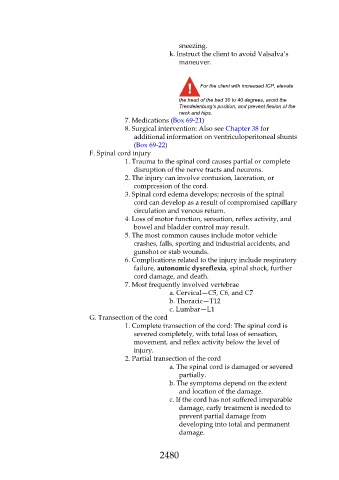Page 2480 - Saunders Comprehensive Review For NCLEX-RN
P. 2480
sneezing.
k. Instruct the client to avoid Valsalva’s
maneuver.
For the client with increased ICP, elevate
the head of the bed 30 to 40 degrees, avoid the
Trendelenburg’s position, and prevent flexion of the
neck and hips.
7. Medications (Box 69-21)
8. Surgical intervention: Also see Chapter 38 for
additional information on ventriculoperitoneal shunts
(Box 69-22)
F. Spinal cord injury
1. Trauma to the spinal cord causes partial or complete
disruption of the nerve tracts and neurons.
2. The injury can involve contusion, laceration, or
compression of the cord.
3. Spinal cord edema develops; necrosis of the spinal
cord can develop as a result of compromised capillary
circulation and venous return.
4. Loss of motor function, sensation, reflex activity, and
bowel and bladder control may result.
5. The most common causes include motor vehicle
crashes, falls, sporting and industrial accidents, and
gunshot or stab wounds.
6. Complications related to the injury include respiratory
failure, autonomic dysreflexia, spinal shock, further
cord damage, and death.
7. Most frequently involved vertebrae
a. Cervical—C5, C6, and C7
b. Thoracic—T12
c. Lumbar—L1
G. Transection of the cord
1. Complete transection of the cord: The spinal cord is
severed completely, with total loss of sensation,
movement, and reflex activity below the level of
injury.
2. Partial transection of the cord
a. The spinal cord is damaged or severed
partially.
b. The symptoms depend on the extent
and location of the damage.
c. If the cord has not suffered irreparable
damage, early treatment is needed to
prevent partial damage from
developing into total and permanent
damage.
2480

